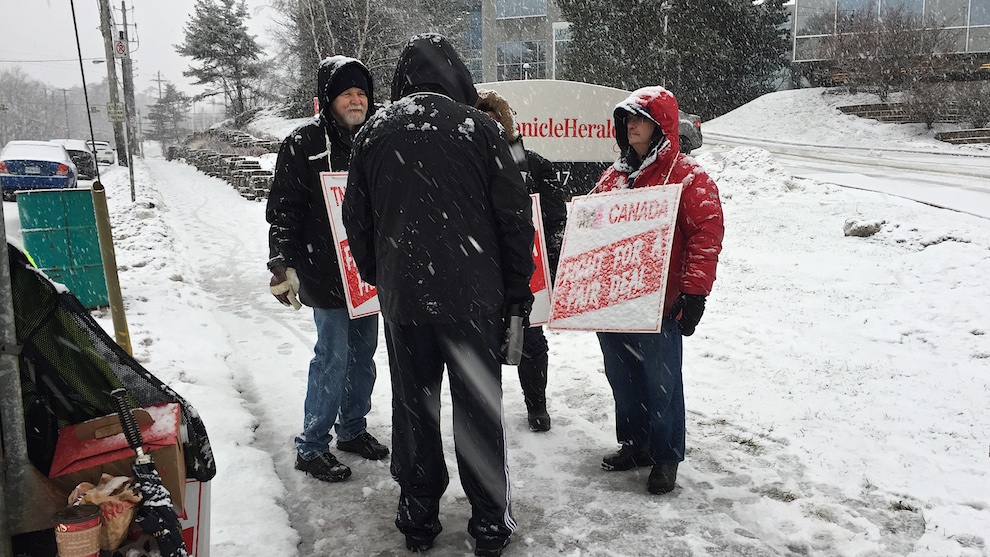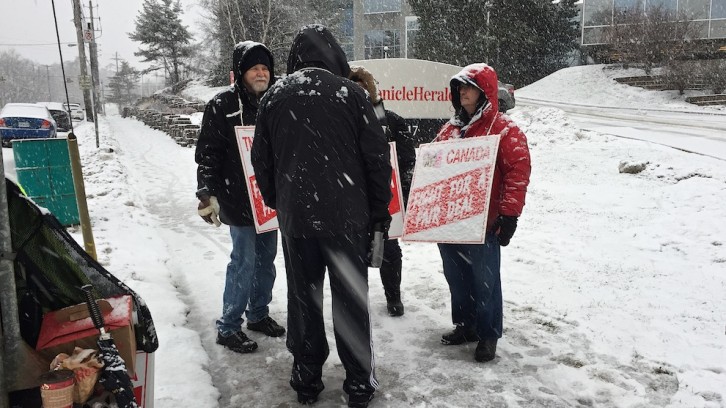Labour Dispute
Photographer: ‘We’re dead men walking’
Striking Herald photographer is worried about prospects

caption
Striking employees walk the picket line outside the entrance to the Chronicle Herald on Joseph Howe Drive.
caption
Striking employees walk the picket line outside the entrance to the Chronicle Herald on Joseph Howe Drive.The real estate agent was showing them the kitchen when Tim Krochak’s wife pointed to a newspaper clipping on the fridge. Krochak, a news photographer, recognized his photo immediately.
“You know it meant something to somebody,” said Krochak. “For that person, at that time, it meant something.”
The supportive honk of a passing car brings him back and Krochak’s smile fades along with the memory. Related stories
Krochak spent the last 18 years working as a professional photographer for the Chronicle Herald. He has spent the last two weeks on the picket line.
When the strike began, he says 18 of his fellow employees received layoff notices, four of whom are photographers. There are six professional photographers at the Herald.
Although Herald management suspended the layoff notices on Jan. 24, Krochak says he is still concerned.
He says the last few months have been like “a slow moving car accident.”
“We’re dead men walking,” said Krochak.
The evolution of news
Krochak laments the trend in recent years of news organizations pushing journalists to author multimedia content.
“There’s a certain Darwinism that we have in this kind of society,” said Krochak. “The digital age is making everyone redundant.”
The president of News Photographers Association of Canada, Amber Bracken, agrees photojournalists are particularly hard hit these days.
“We’ve seen a large percentage of remaining staff positions lost recently, with prospects to lose more,” said Bracken.
She says she doesn’t know what the job structure will look like for professional photographers moving forward.
“If things happen badly at the Chronicle Herald, at the end of this labour dispute we’re not seeing another brick and mortar newspaper spring up to replace it,” said Bracken.
“Freelancing is pretty much the only way forward,” she said.
Chronicle Herald president and CEO Mark Lever declined to comment for this story.
Looking to the future
Krochak says he was asked to learn Instagram, Twitter and Vine, as well as video editing programs.
He hopes the time he spent learning the platforms will give him the edge and versatility to survive in the industry.
Eric Wynne, a fellow photographer at the Herald, says the trend toward shorter stories — and fewer photos — is part of the “natural evolution of journalism.”
“You used to be able to sit down and read in-depth stories,” said Wynne. “We’ve been starved of this stuff for years.”
Krochak says photojournalism is essential in adding value to stories and portraying more information to the reader.
“It’s a really great way of storytelling.” He says he’s sorry “that they want to get rid of the people who help produce that stuff.”

